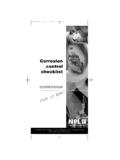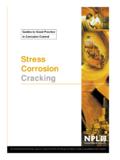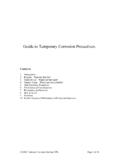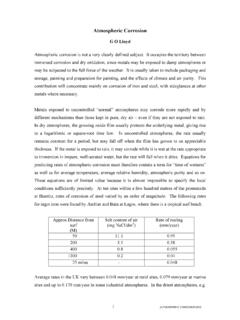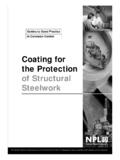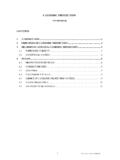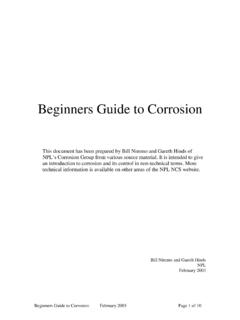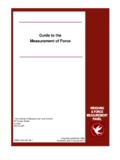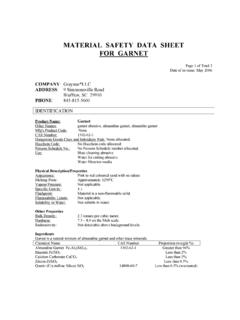Transcription of Surface Preparation for Coating
1 2295/aaron/IK/0004 Guides to Good Practice in Corrosion ControlThe National Physical Laboratory is operated on behalf of the DTI by NPL Management Limited, a wholly owned subsidiary of Serco Group plcSurfacePreparationfor CoatingContents Preparation of new steelwork 1(paint and metal coatings) of Hand and power tool 2cleaning (St Grades) blast cleaning (Sa Grades) condition immediately4before Additional Surface Soluble iron corrosion Preparation of new metal 5coated dip galvanizing5(i) Mordant solution ( T Wash)5(ii) Weathering6(iii) Etch primers6(iv) Sweep sprayed Preparation of previously coated 7surfaces for maintenance abrasive blast Wet abrasive blast pressure water hand and power 9tool Preparation for maintenance painting11of metal Inspection and quality Additional reference standards and12further sources of sources of information15 SurfacePreparationfor CoatingThis is an update of a DTI publication first issued in 1982.
2 The new versionhas been prepared by Dr. R. Hudson of Corus Group plc under contractfrom NPL for the Department of Trade and Preparation is the essential first stage treatment of a substrate before the application of any Coating . The performance of a Coating is significantly influenced by its ability to adhere properly to the substrate material. It is generally well established that correct Surface Preparation isthe most important factor affecting the total success of Surface treatment. The presence of even small amounts ofsurface contaminants, oil, grease, oxides etc. can physicallyimpair and reduce Coating adhesion to the contaminants that are not readily visible, such aschlorides and sulphates, attract moisture through Coating systems resulting in premature failure.
3 In summary, the importance of a chemically clean substrate to provide the bestpossible contact Surface for the applied Coating cannot scope of this guide covers the Surface Preparation ofmetallic surfaces for the subsequent application of paint andmetal coatings for corrosion protection or the enhancement ofsurface appearance for both new structures and adhesion of Coating materials such as zinc by hot dip galvanising is particularly good due to the metallurgical alloying with the steel Surface . In this process, the molten zincreacts with the steel to form a series of iron / zinc alloy layersof varying composition to form an intimate bond with the , metal coatings applied by thermal sprayingrequire a coarse Surface profile to maximise the Coating bondwhich is principally by mechanical paint coatings adhere to the Surface mainly by polaradhesion which is aided by mechanical adhesion which isespecially important for thick Coating all types of coatings, the Surface condition of the substrateis critical in terms of Coating performance and of new steelwork (paint and metal coatings) requirementsThere is generally more information available for the Preparation of steelwork prior to the application of paints andrelated products than is the case for metal coatings.
4 However,metal coatings require no less attention to the requirementsfor Surface Preparation and guidance should be sought fromthe appropriate to be hot dip galvanized should be preparedaccording to ISO 1461 Hot dip galvanized coatings on fabricated iron and steel articles - Specification and test methods, Annex C . Surface cleaning is normallyachieved by pickling in inhibited acid solutions. Alternatively,abrasive blast cleaning may be specified to achieve a thickgalvanizec Coating . For steelwork to be thermally sprayed, thesurface Preparation is usually in accordance with BS EN 22063 Metallic and other inorganic coatings - thermal spraying -Zinc, aluminium and their alloys . surfaces to be thermallysprayed are normally abrasive blast cleaned to a high standard of conditionHot rolled structural steelwork leaves the last rolling pass at atemperature of 1000 C.
5 As it cools, the Surface reacts withoxygen in the atmosphere to produce mill scale. This is acomplex oxide which appears as a blue-grey tenacious scalecompletely covering the Surface . Mill scale is unstable andwith time water in the atmosphere penetrates fissures in thescale and rusting of the steel occurs. The corrosion processprogressively detaches the mill scale and produces a variablesurface that is generally unsuitable for amount of rusting is dependent upon the length of timethat the steel has been exposed to a damp or wet categories of rust grades for new steelwork aredescribed in ISO 8501-1: 1988 (BS 7079 Part A1, 1989) asfollows:A - Steel Surface largely covered with adhering mill scale, butlittle if any - Steel Surface which has begun to rust and from whichmill scale has begun to Preparation for CoatingSurface Preparation for CoatingtwoC - Steel Surface on which the mill scale has rusted away orfrom which it can be scraped, but with slight pitting undernormal - Steel Surface on which the mill scale has rusted away andon which general pitting is visible under normal majority of new steelwork usually conforms to A and Bconditions and occasionally C condition.
6 In either case, thesubstrates can be prepared to an equally good standard byabrasive blast contaminantsResidues of oil, grease, marking inks, cutting oils etc. afterfabrication operations will seriously affect the adhesion ofapplied coatings and must be removed. It is erroneous tothink that subsequent cleaning operations will remove suchcontaminants and it is bad practice to permit them to remainon the Surface . Failure to remove these contaminants beforeblast cleaning results in them being distributed over the steelsurface and contaminating the organic solvents, emulsion degreasing agents orequivalents should be applied to remove contaminants inpreparation for subsequent descaling treatments. Furtherguidance can be obtained from BS 7773 Code of Practice forCleaning and Preparation of Metal surfaces .
7 Of preparationBecause a mill scaled Surface is unsuitable for most moderncoatings, it should be removed. Various methods and gradesof cleanliness are presented in ISO 8501-1: 1988, (BS 7079,Part A1 1989), Preparation of Steel Substrates BeforeApplication of Paints and Related Products - VisualAssessment of Surface Cleanliness .This standard essentially refers to the Surface appearance of the steel after abrasive blast cleaning (dry blasting) andgives descriptions with pictorial references of the grades ofcleanliness.(Note: There is a Supplement 1 to this standard that includespictorial references for 6 different types of abrasives whilst themain standard refers to the condition of the steel after gritblasting only).The standard grades of cleanliness for abrasive blast cleaning are:Sa 1 Light blast 2 Thorough blast 21/2 Very thorough blast 3 Blast cleaning to visually clean surfaces should be compared with the appropriatereference photograph in the standard according to the treatment very wide range of of non-metallic (metal slags, aluminiumoxide etc) and metallic (steel shot or grit etc) abrasives areavailable and these are covered in ISO 11124/1 to 4,ISO11125/1 to 7, ISO 11126/1 to 8 and ISO 11127/1 to 7.
8 NewISO standards for staurolite and garnet abrasives are particle size of the abrasive is also an important factor inaffecting the rate and efficiency of cleaning . In general terms,fine grades are efficient in cleaning relatively new steelwork,whereas coarse grades may be required for heavily corrodedsurfaces. The removal of rust from pitted steel is more easilyeffected by fine grades and, depending upon the condition ofthe steel Surface , a mixture of grades may be required initiallyto break down and remove mill scale and clean in and power tool cleaning (St Grades) Surface cleaning by hand tools such as scrapers and wirebrushes is relatively ineffective in removing mill scale oradherent rust. Power tools offer a slight improvement overmanual methods and these methods can be approximately30% to 50% effective but are not usually utilised for new steelwork fabrications.
9 (More information on hand and power tool cleaning is given inSection 5 - Preparation for Maintenance Painting). blast cleaning (Sa Grades)By far the most significant and important method used for thethorough cleaning of mill-scaled and rusted surfaces is abrasive blast cleaning . This method involves mechanicalcleaning by the continuous impact of abrasive particles athigh velocities on to the steel Surface either in a jet stream ofcompressed air or by centrifugal impellers. The latter methodrequires large stationary equipment fitted with radial bladedwheels onto which the abrasive is fed. As the wheels revolveat high speed, the abrasive is thrown onto the steel Surface ,the force of impact being determined by the size of the wheelsand their radial velocity. Modern facilities of this type use several wheels, typically 4 to 8, configured to treat all the surfaces of the steel being cleaned.
10 The abrasives are recycled with separator screens to remove fine particles. This process can be 100% efficient in the removal of millscale and 1. Modern automatic shot blast profile/amplitudeThe type and size of the abrasive used in blast cleaning havea significant effect on the profile or amplitude produced. In addition to the degree of cleanliness, Surface preparationspecifications need to consider roughness relative to thecoating to be applied. For example, shot abrasives are usedfor thin film paint coatings such as pre-fabrication primers,whereas thick or high build paint coatings and thermallysprayed metal coatings need a coarse angular Surface profileto provide a mechanical key. Inadequate quality control andlack of restriction of large abrasive particle sizes for thin priming coats can lead to peaks of the blast cleaned surfacenot being adequately covered and may produce rust spots veryquickly.
